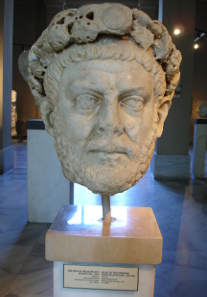with the kind permission of the MoneyMuseum, Zurich
Why is it that for centuries – or rather thousands of years – the head has served as the motif for the side of a coin? And why has this changed in the last 200 years? Ursula Kampmann poses these questions in her book ‘MenschenGesichter,’ from which the texts for our new series are taken.
Roman Imperial Times. Diocletian (284-305). Follis (or nummus), Ticinum, 297. Laureate head of Diocletian r. Rev. Genius of the Roman people, holding scales in the right hand and a cornucopia in the left arm. © MoneyMuseum, Zurich.
It seems that the end of the Roman world has come. Belligerent tribes stand at the borders, peering hard at the Roman wealth. The country experiences inflation. The imperial tax annihilates family assets. Apparently, the gods had left Rome for good. But then, Diocletian enters the arena, a man from Dalmatia, a common soldier of humble upbringing, and he does something that will survive the generations to come: he lays the foundation of a new Rome.
Bust of Diocletian in the Archaeological Museum at Istanbul. Source: Wikicommons.
First of all, the emperor secured the borders. That wasn’t easy to accomplish but manageable with an army comprising c. 500,000 soldiers. He gets himself help – in the form of three caesars, each ruling over a quarter-division of the empire – therewith preventing any fight with usurpers who hitherto had drained so much energy from the Roman central power. Then, the emperor has the expenses of his state calculated, of his army, the four imperial budgets and the administration – then Diocletian creates the first national budget in the history of the world. He puts a number on expenditures and makes sure that tax receipts meet public spending.
That, however, wasn’t easy. The borders could only be successfully secured when expenses were allotted equally. By this time, tax was paid to the state not only just in cash but in crops for the most part. Crops, on the other hand, had to be transported, stored and managed. Diocletian would have preferred to be paid with stable money. Hence, he carried out a monetary reform: he had gold coins minted with a constant fineness and a determined weight, silver coins that actually consisted of silver and a type of debased bronze coin whose actual name is unknown to us but is referred to as follis today.
It didn’t work out, though. National economy, as we today call it, was still in its infancy back then. Diocletian failed to realize that monetary circulation had to conform to the goods circulating. In the Roman Empire, there were more bronze coins than goods resulting in an inflation of small change. Diocletian wanted to prevent that from happening and launched a new law that doubled the value of the bronze coins. At the same time, he issued an edict that imposed a price ceiling on all sorts of goods and services.
It was destined to fail. For the next millennium barter trade was without any alternative, and the Edit on Maximum Prices was abolished without much ado when Diocletian resigned.
In the next chapter you will see to what extent the image that historians have created of Constantine the Great comes near to the truth.
All sections of the series can be found here.
The book ‘MenschenGesichter’ is available in printed form from the Conzett Verlag website. It soon will be translated to English …






